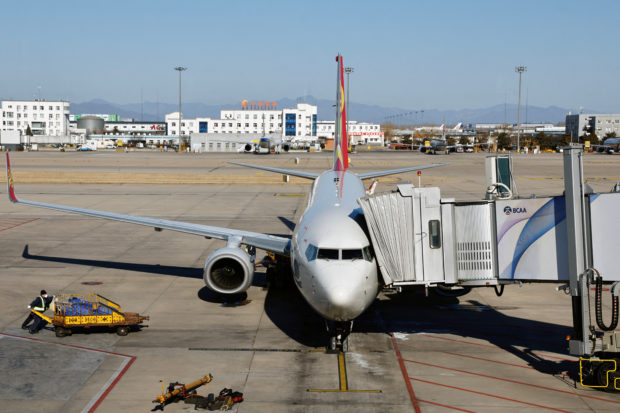
A Hainan Airlines aircraft is seen at Beijing Capital International Airport, amid the coronavirus disease (COVID-19) outbreak in Beijing, China December 27, 2022. REUTERS
SHANGHAI/BEIJING — Chinese people, cut off from the rest of the world for three years by COVID-19 curbs, flocked to travel sites on Tuesday ahead of borders reopening, even as rising infections strained the health system and roiled the economy.
Zero-tolerance measures – from shuttered borders to frequent lockdowns – have battered China’s economy since early 2020, fueling last month the mainland’s biggest show of public discontent since President Xi Jinping took power in 2012.
His policy U-turn this month means the virus is now spreading largely unchecked across the country of 1.4 billion people.
Official statistics, however, show no new COVID deaths reported for the six days through Sunday, fueling doubts among health experts and residents about the government’s data.
Doctors say hospitals are overwhelmed with five- to six-times more patients than usual, most of them elderly. International health experts estimate millions of daily infections and predict at least one million COVID deaths in China next year.
Nevertheless, authorities are determined to dismantle the last vestiges of their zero-COVID policies.
In a major step towards easing border curbs cheered by Asian stock markets on Tuesday, China will stop requiring inbound travelers to go into quarantine from Jan. 8, the National Health Commission said late on Monday.
“It finally feels as if China has turned the corner,” AmCham China Chairman Colm Rafferty said of the planned lifting of quarantine restrictions.
Data from travel platform Ctrip showed that within half an hour of the news, searches for popular cross-border destinations on had increased 10-fold. Macau, Hong Kong, Japan, Thailand, South Korea were the most sought-after, Ctrip said.
Data from another platform, Qunar, showed that within 15 minutes of the news, searches for international flights jumped seven-fold, with Thailand, Japan and South Korea at the top of the list.
China’s management of COVID will also be downgraded to the less strict Category B from the current top-level Category A from Jan. 8, the health authority said, as it has become less virulent.
The change means authorities will no longer be compelled to quarantine patients and their close contacts and lock down regions.
But for all the excitement of a gradual return to a pre-COVID way of life, there was mounting pressure on China’s healthcare system, with doctors saying many hospitals are overwhelmed while funeral parlour workers report a surge in demand for their services.
Nurses and doctors have been asked to work while sick and retired medical workers in rural communities were being rehired to help, state media reported. Some cities have been struggling to secure supplies of anti-fever drugs.
“Just look at the funeral parlours in various cities. I heard that we have to queue for three to five days for cremation here,” one person in the eastern Shandong province complained on social media.
Near-term pain
While the world’s second-largest economy is expected to see a sharp rebound later next year, once the initial shockwave of infections fades, it is in for a rough ride in the coming weeks and months as workers increasingly fall ill.
Many shops in Shanghai, Beijing and elsewhere have been forced to close in recent days with staff unable to come to work, while some factories have already sent many of their workers on leave for the late January Lunar New Year holidays.
“The concern of a temporary supply chain distortion remains as the labour force is impacted by infections,” JPMorgan analysts said in a note, adding that their tracking of subway traffic in 29 Chinese cities showed that many people were restricting their movements as the virus spreads.
Data on Tuesday showed industrial profits fell 3.6% in January-November from a year earlier, versus a 3.0% drop for January-October, reflecting the toll of the anti-virus curbs in place last month, including in major manufacturing regions.
The lifting of travel restrictions is positive for the $17 trillion economy, but strong caveats apply.
“International travel … will likely surge, yet it may take many more months before volumes return to the pre-pandemic level,” said Dan Wang, chief economist at Hang Seng Bank China.
“COVID is still spreading in most parts of China, greatly disrupting the normal work schedule. Loss in productivity is significant and inflationary pressures in the coming months could be acute as the sudden spike in demand will outpace the recovery in supply.”
RELATED STORIES
‘Go all out’: China prepares for COVID spread as holiday travel looms
Few Chinese keen to travel abroad soon, even if COVID-19 curbs ease–report